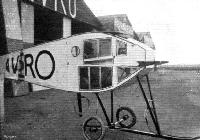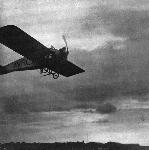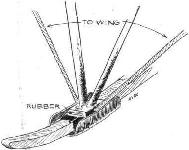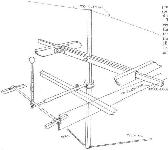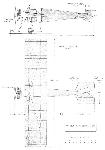A.Jackson Avro Aircraft since 1908 (Putnam)
Avro Type F
In the spring of 1912 A. V. Roe’s fertile mind conceived the idea of an enclosed aeroplane affording the occupants complete protection from the elements. He straightway designed two such machines, the first of which was a single seat, mid-wing monoplane known as the Type F.
Structurally similar to the Avro 500, it used the same undercarriage, tail unit and small rudder (this time linked to a steerable tail skid), but there the similarity ended. The box-girder fuselage was of streamlined shape built up from four wooden longerons and cross struts, reinforced by triangular plywood stiffeners in each bay and braced internally with piano wire. By unlacing the fabric half way along the rear fuselage to expose steel jointing plates, the fuselage could be taken apart quite easily to facilitate packing. Its maximum width was only 2 ft but there was sufficient depth for the pilot to sit wholly inside with a somewhat restricted view through a number of celluloid windows. Entry was through a sheet aluminium trapdoor in the roof and large circular holes were provided in each side through which the head could be thrust when flying in poor visibility. Fuel and oil tanks were situated inside the fuselage, remote from the engine to reduce risk of fire.
The mainplane, constructed in two halves round a built-up front spar, was mounted on the centre line of the fuselage and braced by wires to a stout kingpost under the fuselage and to a pylon of steel tubes on top. Lateral control was by wing warping.
The Type F monoplane was erected at Brooklands in April 1912 and Wilfred Parke made the first take-off on May 1, climbing the machine steeply on half throttle. It was the first flight in the world by an aeroplane with a totally enclosed cockpit. Critics predicted that oil thrown back by the 35 hp Viale five cylinder radial engine would completely obscure the pilot’s vision but this proved not to be the case. It was a carefully maintained engine well known to Parke, being that taken from the Type D school machine which he had flown from Brooklands to Abingdon in the previous January. First circuits were made on May 3 and test flying continued until May 17 when, during a flight over Chertsey, 1,000 ft was reached for the first time. On May 25 it was decided to show the machine at Hendon but the engine failed soon after take-off and in the ensuing forced landing at Weybridge, Parke hit a fence and turned over. There was little damage and the Type F was dismantled by four men in 25 minutes for return to the workshops.
For some months the machine languished at Brooklands until taken out by R. H. Barnwell on September 13. After one or two straight hops, the front part of the skid was broken in landing and the aircraft turned over, suffering serious damage in the process. Barnwell was unhurt but it is evident that the Type F did not fly again.
SPECIFICATION AND DATA
Manufacturers: A. V. Roe and Company, Brownsfield Mills, Great Ancoats Street, Manchester; and Brooklands Aerodrome, Byfleet, Surrey
Power Plant: One 35 h.p. Viale
Dimensions:
Span 28 ft. 0 in. Length 23 ft. 0 in.
Wing area 158 sq. ft.
Weights: Tare weight 550 lb. All-up weight 800 lb.
Performance: Maximum speed 65 m.p.h. Initial climb 300 ft./min.
Production: One aircraft only, first flown at Brooklands 1.5.12, damaged beyond repair at Brooklands 13.9.12. Engine preserved at the Science Museum, London, and the rudder by the Royal Aero Club.
Показать полностью
M.Goodall, A.Tagg British Aircraft before the Great War (Schiffer)
Deleted by request of (c)Schiffer Publishing
AVRO Type F monoplane
One of the first aeroplanes where the pilot was seated inside the fuselage for the maximum protection. The pilot entered through a door in the roof of the cabin and was provided with a celluloid windscreen and various windows for vision. In addition a circular opening was provided on each side. The fuselage was built with a joint, at a point midway between the wing and the tail, for ease of dismantling and transport. The undercarriage and tail units were similar to those of the type E. The wing, of single spar construction, was attached at the fuselage centerline and was braced to the fuselage by a kingpost below and a pylon above.
The monoplane was flown at Brooklands on 1 May 1912 for the first time by W. Parke, who was involved at the end of May in a forced landing at Weybridge. After repairs at Brooklands it saw little use until 13 September, when being flown by R.H. Barnwell, it turned over on landing and was not repaired.
Power: 35hp Viale five-cylinder air-cooled radial previously fitted in the sixth Type D. Currently preserved in the Science Museum.
Data
Span 28ft
Length 23 ft
Area 158 sq ft
Weight 550lb
Weight allup 800lb
Max speed 65 mph
Показать полностью
P.Lewis British Aircraft 1809-1914 (Putnam)
Avro F
The Avro F was a typical example of A. V. Roe's foresight and inventiveness. Designed in 1911 and assembled at Brooklands in April, 1912, the first Avro monoplane constituted a great advance in design with its completely enclosed cabin for the crew, and was the first machine in the world to embody such an innovation.
The fuselage was of excellent streamline form for the period, reflecting in no uncertain manner its designer's appreciation of the value of reduction of head-resistance and drag. Other features were the mid-fuselage position for the wings and the liberal amount of celluloid window glazing which was used on the top, sides and underneath of the fore-body. Open circular ports were made to the rear of the side windows in case of misting-up, and access to the cabin was through a trap-door in the roof of the fuselage. The undercarriage consisted of a pair of wheels on a leaf-spring axle which was attached to the fuselage by two pairs of steel-tube vee struts, combined with a central skid.
Lateral control was applied by warping of the parallel-chord wings. The engine chosen for the Avro F was the five-cylinder 40 h.p. Viale, which was mounted uncowled and had previously been installed in an Avro 500.
After preliminary ground testing, Lt. Wilfred Parke took the machine into the air at Brooklands in May, 1912, becoming the first pilot to fly, and subsequently to demonstrate, a totally enclosed cabin aeroplane.
SPECIFICATION
Description: Two-seat tractor monoplane. Wooden structure, fabric covered.
Manufacturers: A. V. Roe & Co., Brownsfield Mills, Manchester.
Power Plant: 40 h.p. Viale.
Dimensions: Span, 29 ft. Length, 23 ft. Wing area, 160 sq. ft.
Weights: Empty, 550 lbs. Loaded, 800 lb.
Performance: Maximum speed, 65 m.p.h.
Показать полностью
Jane's All The World Aircraft 1913
AVRO. Aeroplanes. A.V. Roe & Co., Clifton Street, Miles Platting, Manchester; also Shoreham, Sussex. A.V. Roe designed his first machine, a biplane, in 1906. It was the first British machine to leave the ground. He then experimented with triplanes in Lea Marshes, where he managed to fly with only 9 h.p. in 1908-9. In August, 1910, built Roe III, and in September, Roe IV, also triplanes (see 1911 edition for full details). In 1911 he abandoned triplanes for the Avro biplane. School: Shoreham.
D 1911-12. E 1912. F 1912. G 1912-13. E 1912-13.
Model. 2-seater 2-seater Totally Totally Hydro-biplane.
biplane. biplane. enclosed enclosed
mono. biplane.
Length.....feet(m.) 31 (9.45) 29 (8.84) 23 (7) 29 (8.84) 33 (10)
Span.......feet(m.) 31 (9.45) 30 (11) 28 (8.50) 36 (11) 47-1/2 (14.50)
Area....sq.ft.(m^2.) 279 (26) 335 (32) 158 (14-1/2) 335 (32) 478 (34-1/2)
Weight, empty lbs.(kgs.) 800 (363) 900 (482) 550 (249) 1191 (540) 1740 (789)
Weight, fully loaded, lbs. (kgs.) ... 1300 (589) 800 (363) 1700 (771) 2700 (1224)
Motor...........h.p. 35, any 50 Gnome 40 Viale 60 Green 100 Gnome
make
Speed....m.p.h. (km.) 48 (78) 61 (97) 65 (105) 61.8 (100) 55 (90)
Number built
during 1912....... several 6 1 1 1
Remarks.--Of the above, 4 of the 50 Gnome E type were purchased by the British Royal Flying Corps, and one by the Portuguese Government; the other went to Windermere on January, 1913, for hydro experiments. Climbing speed of this type is 440 feet per min. (134 m.) Dual control fitted. D type are no longer being built. Climbing speed of F type, 300 feet per min. (91.5 m.) Gliding angle, 1 in 6. G has a gliding angle 1 in 6.5. On October 24th, 1912, made British record to date, 7'31-1/2" (=450 miles). The hydro. was delivered to the British R.F.C. naval wing early in 1913.
Показать полностью
Журнал Flight
Flight, April 13, 1912.
FROM THE BRITISH FLYING GROUNDS.
Brooklands Aerodrome.
<...>
A new comer during the week was the Avro monoplane, which is now in course of erection. This is a highly original machine, about which there is bound to be great divergence of opinion. The rectangular fuselage is very deep, the pilot being completely enclosed, and obtaining his view of the outside world through a number of windows covered with non-inflammable celluloid. The motor, a 50-h.p. Viale, is supported in front outside the covering. The pilot climbs in through a trap-door in the roof, and in the case of an upside down landing makes an emergency exit through the side with a pair of wire cutters.
Flight, October 2, 1912.
THE AVRO MONOPLANE.
NOT SO very many months ago we all, more or less, looked on the all-enclosed aeroplane as a dream of the future. But things move quickly in the aviation world these days, and already Messrs. A. V. Roe and Co. and Lieut. Wilfred Parke, R.N., the clever pilot who flies their machines, have shown us the practicability of this type of craft. This monoplane is entered through an aluminium trapdoor in the top of the body, for all the world as if it were a submarine that was being boarded instead of a flying machine. Inside, the pilot is comfortably seated with his elevation and warping lever between his knees, and his rudder lever at his feet. His switch, throttle, and spark advance levers are to his right hand, and his various other instruments - his altitude recorder, his compass, his revolution indicator, his watch, his map holder, and his level indicator - a very important instrument to use with this type of machine, we should think - are arranged conveniently around him. He takes his bearings, and sees what is going on around him through non-inflammable celluloid windows let into the front of the fuselage. A window sunk into the floor shows him the ground directly beneath him. Those to right and to left reveal the surroundings on either side.
When the machine first arrived at Brooklands it was generally thought - the habitats of that aerodrome invariably sit in solemn conclave on any new arrival - that, with the respiration of the pilot inside, and the fine spray of oil thrown out with the exhaust of the Viale motor, the windows would soon become clouded over, and render clear vision impossible after a few minutes' running. After his longest trip, the underneath window was the only one that showed much mistiness, and the fitting of exhaust pipes leaving the exhaust clear of the windows would undoubtedly cure the trouble, for in the Viale engine there are no auxiliary ports drilled in the cylinder walls to scatter the oil far and wide. Flying through heavy rain might make things rather difficult for the pilot, but then, as a safeguard, there is an open round hole in the body casing on each side through which he can thrust his head if necessary.
We believe there is only one other all enclosed aeroplane in existence as yet, and that is the Rumpler monoplane shown at the last Berlin Aero Exhibition. In this machine the covering for the pilot and passenger is merely a superstructure applied to an apparently standard machine. The fuselage was not especially designed for that purpose as is that of the Avro monoplane.
Two other enclosed body machines have been built, but they can scarcely come under the same category - the 100-h.p. Bleriot berline, for the pilot was accommodated outside the four-seated carriage-built body, and the Piggott monoplane, a British machine, for the fact that it has since the Aero Show of 1911 been modified, so that the pilot's head is outside the body of the machine. Thus, distinction attaches to those responsible for the monoplane under review, to the Avro firm for being the first to produce a machine of this type to prove itself successful in appreciably long flights, and to Lieut. Parke for having done the demonstration work.
The body is, as far as construction is concerned, identical with the later ones manufactured by this firm. The only difference it presents is that the ash longerons are reinforced by the application of triangular lengths of three-ply wood. This point is shown by one of our sketches. Its shape, viewed from one side, is approximately streamline, and exactly symmetrical about its longitudinal axis. In section it is rectangular. At the pilot's seat a section of the body may be represented by a vertical panel, so high that there is about 8 ins. of clearance between the top of the pilot's head and the roof of the fuselage. This measurement concerns the machine's present pilot, and would naturally vary with the overall height, in a sitting posture, of whoever may pilot a similar machine in the future. It is quite conceivable, following up this line of thought, that we shall one of these days be having our aeroplanes "made to measure."
A steel cap embraces the four longitudinal body members in front, and to this the motor - a 35-h.p. 5-cyl. radial air-cooled Viale - is bolted. Further support is provided by two stout ash bearers, which extend horizontally, one on each side, from the front of the body. At the rear end is the tail, but for this organ no description is necessary, for in construction and arrangement it is similar to those we have described in the past in connection with other Avro productions. One point, though, is noticeable - that the tail-skid is sprung in a manner that saves space and reduces the overall height of that section of the machine.
The landing gear, as in the case of the later Avro biplanes is a version of the Nieuport idea. The central skid supports the body through steel struts arranged V fashion - the front ones oval and the rear ones round in section. In both cases they slant forward to take the "drift" of landing. The laminated axle of spring steel is clipped to the skid. For the wings, except that the front spar of I section is built up instead of being hollowed out from the solid, the only point of more than usual originality is the manner in which the rear spars, in warping rock together with the single strut forming the upper and lower cabane, as one unit. This, perhaps, can better be conveyed by the accompanying sketch. The way of operating the warping that this same sketch shows is also highly interesting. Quite a sound point in connection with the engine controls - the main wing and tail controls are, as can be seen, standard Avro - is that they are mounted, the switch, the throttle, and the spark advance lever in a line together. Further, the levers operate in the same direction - that is, both spark and throttle levers are pushed forward to increase engine speed. The advantages of this system as against fitting the levers unsystematically, is too apparent to need dwelling on here.
Flight, April 26, 1917.
THE "TOTALLY ENCLOSED" AEROPLANE.
IT has already been recorded that at the Aero Show held in Berlin in April, 1912, two enclosed machines were exhibited - the Rumpler and the Bavarian Aircraft Works monoplane. At about the same time, early in April, 1912, there arrived at Brooklands aerodrome a new monoplane from the Avro works. During the weeks that followed this machine was taken through its tests by the late Lieut. Wilfred Parke, R.-N., who put up some very good performances, and demonstrated for the first time in England the practicability of the all-enclosed aeroplane.
A good idea of the general arrangement of the Avro enclosed monoplane can be formed from the accompanying illustration. The body, which was of rectangular section, had flat sides, top, and bottom. The front part of it was fitted with celluloid windows in the sides as well as in the roof and floor. Round the windows the covering consisted of sheet aluminium, while the rear part of the body was covered with fabric. Access to the interior was obtained through an aluminium trap door in the roof, and the pilot was comfortably seated inside, with the warp and elevator lever between his knees, his feet resting on two pedals pivoting on a transverse steel tube and operating the rudder. His switch, throttle, and spark advance levers were mounted on the right-hand side of the body, and his various instruments - altitude recorder, compass, revs, indicator, watch, map holder, and inclinometer - were arranged conveniently around him.
When the machine first made its appearance at Brooklands it was generally thought that, with the respiration of the pilot inside and fine spray of oil thrown out with the exhaust of the engine, the windows would soon become clouded over, and render clear vision impossible after a few minutes' running. In practice this was not found to be the case, and after the longest flight made on this machine, the window in the floor was the only one that showed any signs of mistiness. The engine fitted was, it should be remembered, a Viale, which had no auxiliary exhaust ports in the cylinders, but on the other hand no exhaust pipes were employed to lead the gases away from the windows. Had this been done there appears to be no reason to suppose that the window underneath would have clouded over at all. As a precautionary measure a circular opening was provided in each side of the body, on a level with the pilot's head, so that if the windows should get covered with mist or rain it was possible, by looking out through these openings, to obtain a reasonably good view. After several months of very good flying the Avro monoplane was damaged through running into a wire fence that the pilot had failed to notice, and as the firm were then busy on their other machines the monoplane was put on one side, having during its short career provided quite a lot of useful data for the biplane of similar type which was being got out for the Military Trials.
<...>
Показать полностью











